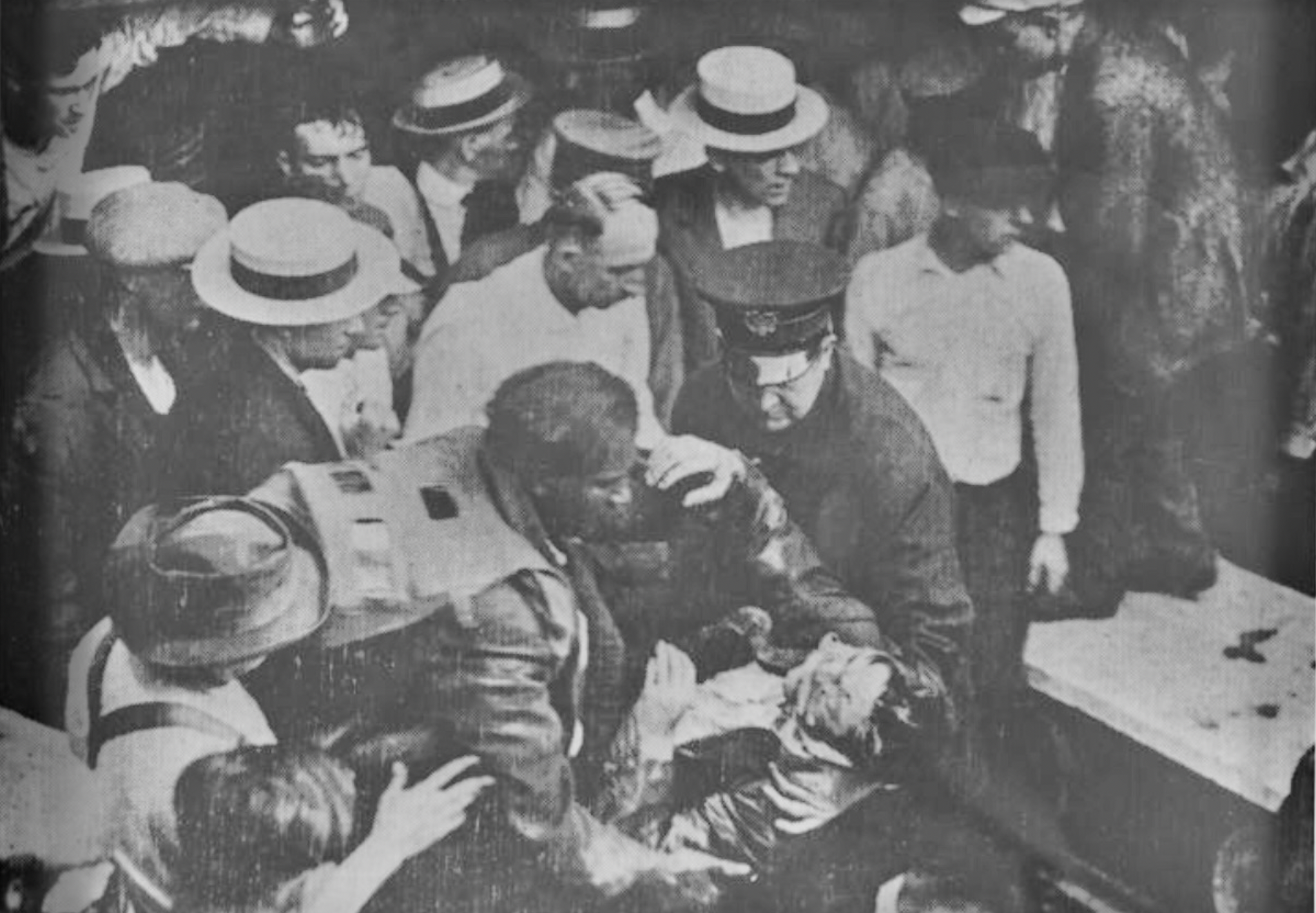Garrett A. Morgan is emerging as a larger-than-life figure in American history.
International recognition for the brilliant Cleveland entrepreneur comes a century after his life-saving inventions helped reshape the modern world — from the battlefield to the firehouse to the family road trip.
He possessed a unique humanitarian gift for turning tragedy into life-saving inventions.
The son of former slaves, Morgan conceived and patented the three-signal traffic control in 1923, after he reportedly witnessed a tragic automobile accident on a Cleveland street corner.
His vision of safer streets now helps control the ebb and flow of millions of automobiles and pedestrians on busy roads all across the globe.
A decade earlier, he patented the first gas mask in response to the Triangle Shirtwaist Factory fire, which killed 146 garment workers, mostly young women, in New York City in 1911.
Garrett A. Morgan (1877-1963) was a Cleveland businessman who invented the modern three-way traffic signal and a breathing device that found service by both soldiers and firefighters. (Western Reserve Historical Society)
He proved the mask’s merits at the risk of his own death during his heroic rescue of trapped tunnel workers following a tragic methane explosion beneath Lake Erie in 1916.
Allied troops also relied on gas masks built on Morgan’s patented technology to protect them from chemical attacks during the trench warfare of World War I. Modern versions of the Morgan breathing device are standard equipment today for firefighters around the world.
CLICK HERE TO SUBSCRIBE TO FOX NATION
“He was an endless inventor. He was an extremely creative and amazing man,” said John Stark Bellamy II, author of the 1995 book “They Died Crawling: And Other Tales of Cleveland Woe,” which chronicles Morgan’s daring exploits in what’s known as the Lake Erie crib disaster.
‘He found solutions’
Twenty-one tunnel workers and would-be rescuers were killed in the methane gas explosion five miles off the coast of Cleveland, according to the Encyclopedia of Cleveland History.
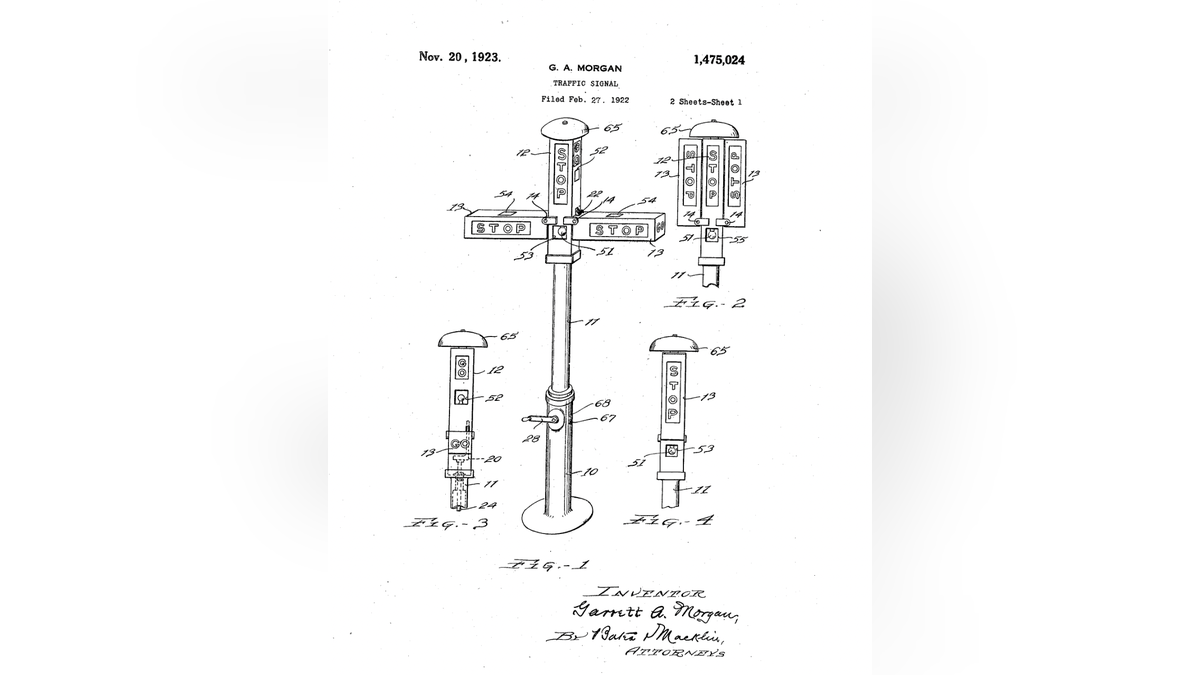
Cleveland inventor Garrett Morgan received a patent in 1923 for a new three-phase traffic signal that including a “slow” or warning phase. Previous traffic signals offered only stop or go functions, often leading to intersection chaos. (Public Domain)
Morgan, his brother Frank and two other men donned his new gas masks, entered the tunnel and pulled out two survivors and four bodies.
Yet The New York Times and other national newspapers of the day failed to mention Morgan in their recap of the disaster, with racism cited by historians today as the reason for the oversight.
“He was an endless inventor. He was an extremely creative and amazing man.”
“There’s no question that he was a hero but that he was treated shabbily, too,” Bellamy said.
Morgan is today being recognized for his creative genius, personal bravery and clear position at the sharp end of the fight for equality.
The short movie, “The Inventor,” is made the film festival circuit in 2022. It was honored for “Best Historic Short” at the Manhattan Film Festival that year.
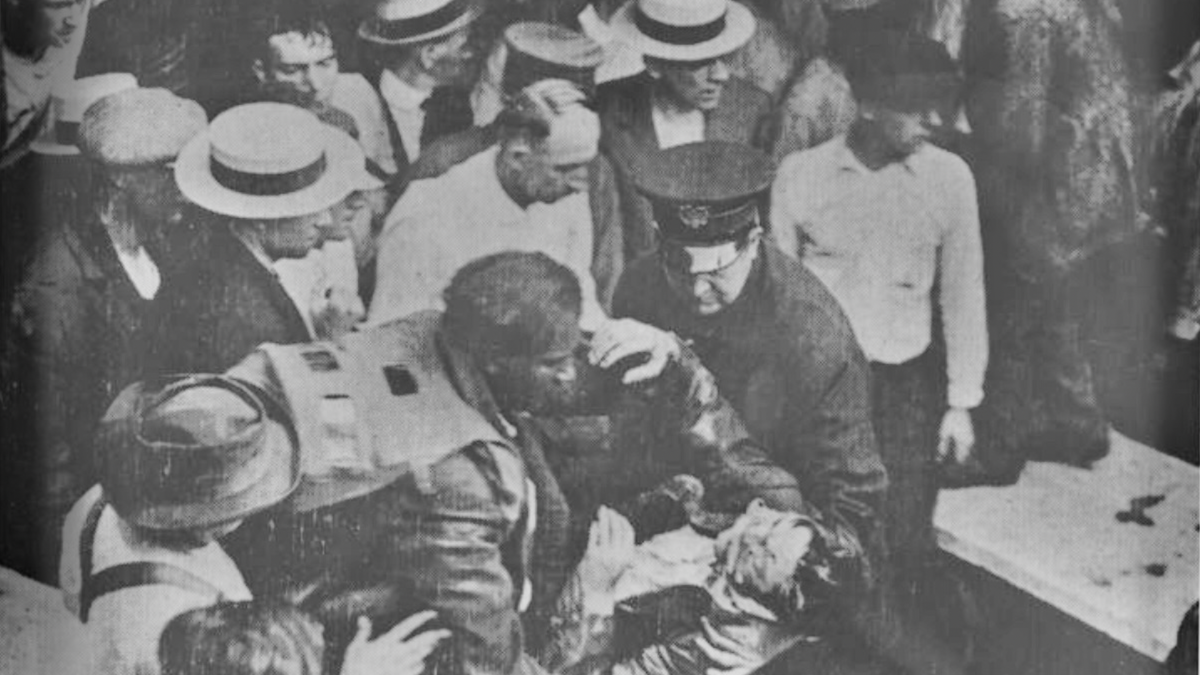
Garrett A. Morgan lifts a tunnel worker from the 1916 Lake Erie crib disaster that killed 21 men. Morgan, along with his brother Frank and two other men wearing his newly patented gas mask, descended into a methane-filled hole beneath the lake bed to find survivors and remove bodies. His gas mask can be seen pulled back off his head and hanging around his shoulders. (Western Reserve Historical Society)
The scientific community recently acknowledged that a Black American, and not a White European, invented the gas mask that Allied troops carried into battle to protect against chemical attacks in World War I.
“By 1917, a year after the Lake Erie disaster, this type of hood was standard equipment (along with British and French designs) for the U.S. Army during World War I,” Smithsonian reported in 2022.
MEET THE AMERICAN WHO INVENTED THE ELECTRIC GUITAR, INSPIRED ROCK ‘N’ ROLL
“The Smithsonian museum has conceded that a Black American invented the life-saving gas mask, not the Scottish physician [John Scott Haldane] who has been widely credited,” The Times of London noted in response.
“Garrett Morgan saw problems in the world and he found solutions,” filmmaker Cabral Clements told Fox News Digital.
The co-producer of “The Inventor” said he first learned of Morgan’s creative genius while working on a third-grade research project. “His story stuck with me,” he said.
Grandson of a Confederate general
Morgan was born on March 4, 1877, in Paris, Kentucky, with a uniquely American multi-racial background.
The family believes that John Hunt Morgan, a Confederate general known for his daring raids into Union territory — and for his dalliances with women he owned as property — is Morgan’s grandfather.
The inventor’s family is seeking DNA confirmation of their relationship with the general, said Sandra Morgan, Garrett’s granddaughter, to Fox News Digital.
“We’re anxious to know,” said Morgan, a Kent State University business development executive.
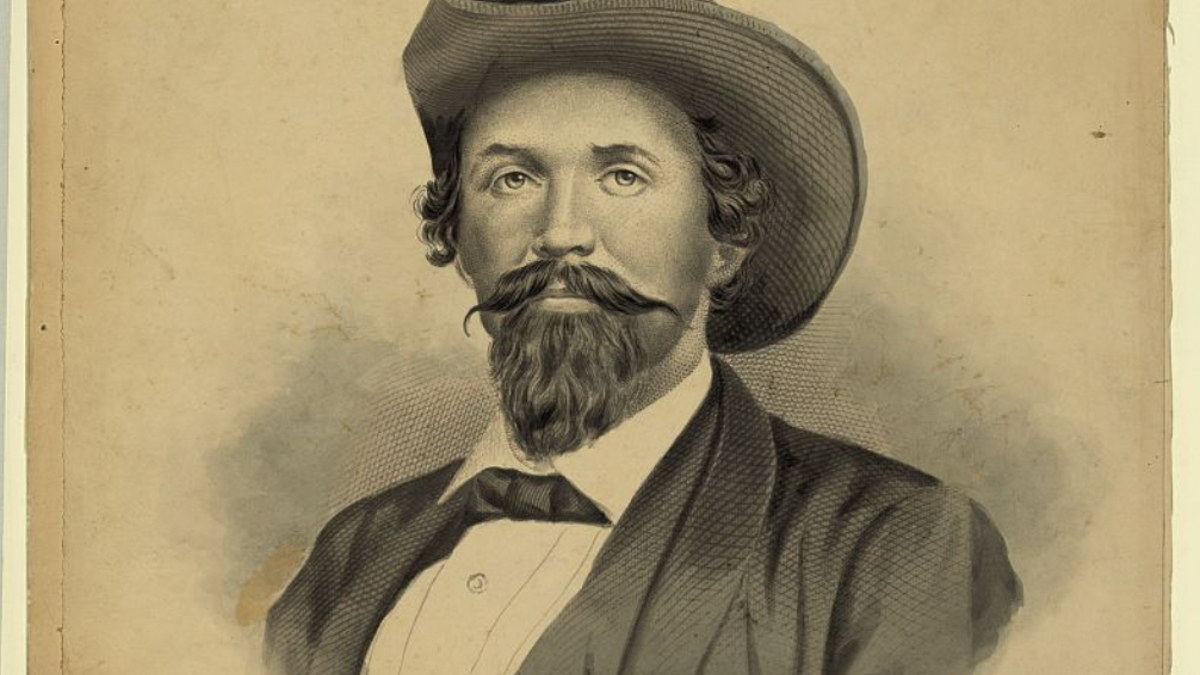
Gen. John Hunt Morgan was a Confederate calvary office known for his daring raids into Ohio. He’s believed to be the grandfather of American inventor Garrett A. Morgan, the son of freed slaves. (Library of Congress)
Gen. Morgan’s attack on Salenville, Ohio, in late July 1863 — just weeks after the rebel defeat at Gettysburg, Pa. — marked the northernmost advance of Confederate forces during the Civil War.
He was killed in battle in Greenville, Tenn., on Sept. 4, 1864. Sydney Morgan — the general’s son and father of the inventor — was freed after the cavalry officer’s death.
MEET THE AMERICAN WHO WROTE ‘THE BATTLE HYMN OF THE REPUBLIC’
Sydney married another former slave, Eliza Reed, sometime after the war. They were both of mixed-race descent (including Native American for Reed), according to the most current family knowledge, said Sandra Morgan.
“They were not farmhands. They lived in the city,” meaning Lexington, Ky., she said. “They were urbanites. They had exposure to many different things. Sydney couldn’t read or write, I don’t believe. But he had city smarts.”
Garrett A. Morgan, the seventh of their 11 children, carried those smarts with him when he ventured north across the Ohio River, making his way to Cleveland around 1895.
He proved adept at business with an incredible mechanical aptitude, despite possessing only a fifth- or sixth-grade level education.
He landed a job in the garment industry, inventing among other things a zigzag stitch pattern for sewing machines. He soon stopped working for others, opening his own sewing store and then a hair products company, G.A. Morgan Hair Refining Co.
It stayed in business until 1976, the family said.
He also became active in civic affairs, especially those championing African-American success. He helped found the Cleveland Association of Colored Men in 1908 and the all-Black Wakeman Country Club, on land he purchased in 1923, according to the Encyclopedia of Cleveland History.
He married Mary, a first-generation American whose parents immigrated from Bohemia, now part of the Czech Republic.
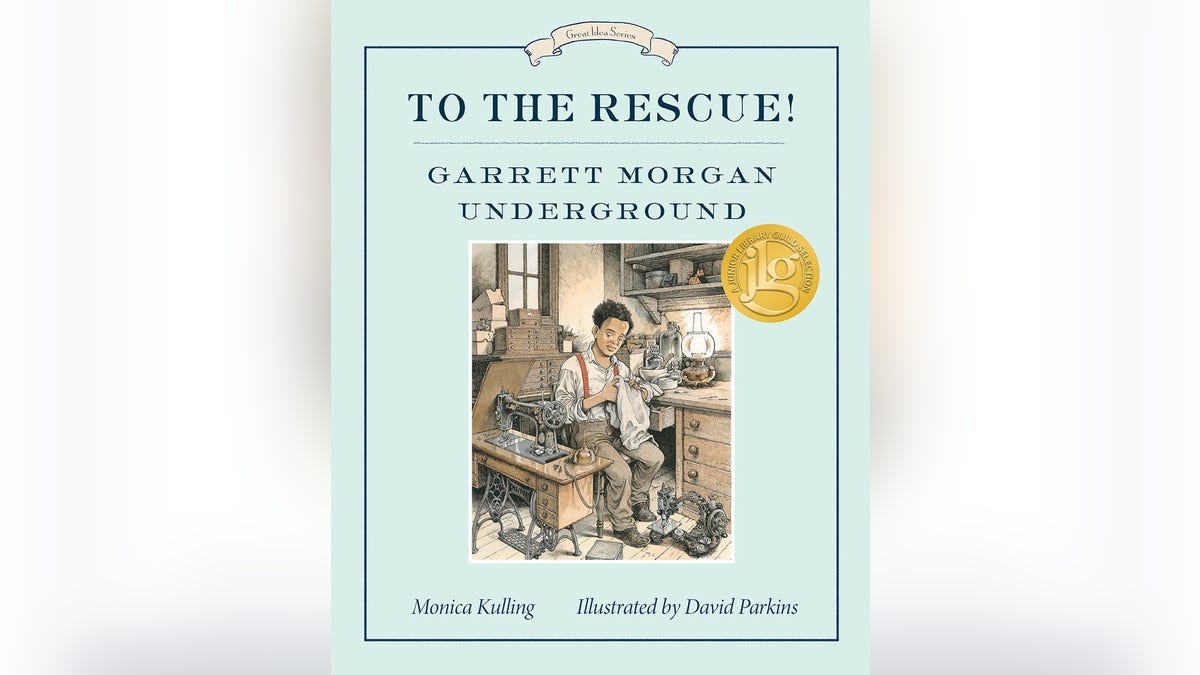
This 2016 children’s book by Monica Kulling tells the dramatic story of American entrepreneur Garrett Morgan, who, among other inventions, risked his life to prove the effectiveness of his patented breathing device. (David Parkins illustration/Tundra Books)
The mixed-race family felt the sting of public prejudice: Mary was ex-communicated from the Catholic Church by the local bishop for marrying a Black man, Sandra Morgan said. But the couple forged a formidable partnership.
The couple owned a hugely successful ladies’ clothing store, which employed up to 32 people, according to family history.
MEET THE AMERICAN WHO INVENTED THE MOTOR HOME
After reading about the horror of the 1911 Triangle Shirtwaist fire, Garrett Morgan set about creating a mask to help rescue workers breath safely amid toxic conditions. Many of the 146 who were killed in the New York City fire died of smoke inhalation.
He filed a patent for his “breathing device” in 1912, and received approval in 1914
He struggled to sell the mask, however. He even enlisted a White friend to lead sales calls, hoping the color of his skin would make it an easier sell.

Garrett Morgan filed a patent application for a new breathing device in 1912, which was approved in 1914. His system proved its worth as a gas mask in a 1916 Lake Erie tunnel fire and on the battlefield in World War I. (Public Domain)
The business was never as successful as it could have been, Sandra Morgan told Fox News Digital.
War in Europe exploded in August 1914, just four months after Morgan received his patent. He lent his technology to the U.S. military and its allies to combat the horrific gas attacks of World War I.
AMERICAN SOLDIERS KILLED IN WWI REMEMBERED FOREVER IN NYC ALEHOUSE
“With a few slight modifications [the masks] will withstand chlorine, phosgene and mustard gas,” Garrett Morgan — in the dramatized story of his life portrayed in the new film “The Inventors” — tells his brother Frank.
The movie is “a reminder that Black American contributions to this country have been hugely consequential,” co-producer Philip Musey told Fox News Digital.
A man meets his moment
The knock on the door came before sunrise on the morning of July 25, 1916.
There was a terrible explosion the night before at the Lake Erie crib, an offshore base where tunnel workers lived while digging beneath the lake bed to bring fresh water into Cleveland.

Garrett Morgan’s patented breathing device/gas mask, as it appears in the dramatized version of his life, “The Inventor,” a 2022 short film. (“The Inventor” producers Cabral Clements and Philip Musey)
The blast at 9:22 p.m. “was so powerful that it smashed and hurled the heavy concrete tunnel sections around, killing and burying the crew in a fiery holocaust of flame and dirt,” Bellamy wrote in his book, “They Died Crawling.”
In all, 21 men — both tunnel workers and rescuers — were killed.
Authorities were desperate to find a way to get into the tunnel safely and search for survivors and bodies. One official recalled that Cleveland inventor Morgan had been shopping a breathing device around to fire departments.
“He rustled his brother Frank,” Sandra Morgan told Smithsonian. “They threw a bunch of gas masks in the car — remember, they were selling these things — and in their pajamas, drove down to the lakefront.”
The Morgan brothers plus two volunteers donned the masks and descended into the hole.
“Goodbye,” Cleveland Mayor Harry Davis said to Morgan — “so doubtful was he of the helmet’s effectiveness,” as Bellamy noted in his book.
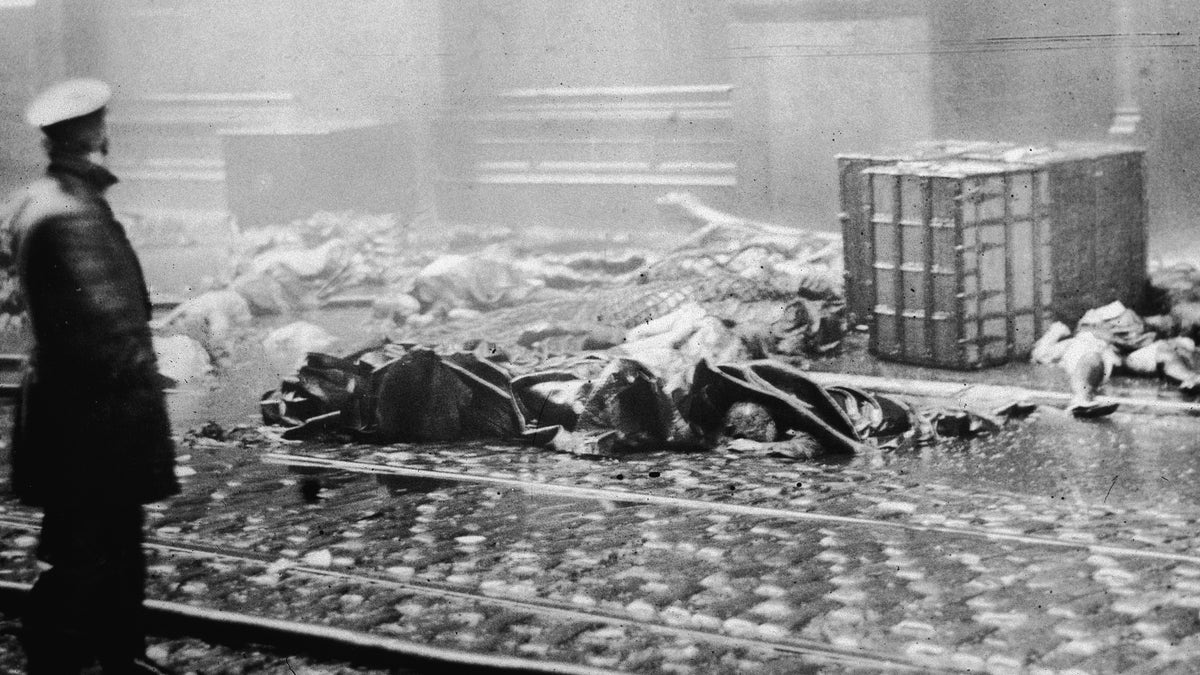
A policeman stands in the street, observing charred rubble and corpses of workers after the Triangle Shirtwaist Company fire in NYC, March 25, 1911. The tragedy inspired Garrett Morgan, a garment-industry entrepreneur in Cleveland, to create a breathing device to aid rescue workers. (Hulton Archive/Getty Images)
But the mask was brilliantly effective.
The national media soaked up the story — yet they failed to mention the real hero of the Lake Erie crib disaster.
COAST GUARD AT LAKE ERIE CONDUCTS MASS RESCUE OF STRANDED SNOWMOBILERS
“The mayor purposely left Morgan out of the story of the rescue because he was Black.” That’s the belief of Scott O’Con of Tours of Cleveland, who includes tales of Morgan’s achievements in his guided trips around the city.
“It took years for the city to actually recognize Morgan for his heroic efforts that day,” O’Con told Fox News Digital.

“They Died Crawling: And Other Tales of Cleveland Woe,” by John Stark Bellamy II, includes the harrowing details of Garrett Morgan’s daring rescue of men during the Lake Erie crib disaster of 1916. (Gray & Co. Publishers)
Four rescue workers received medals from the Carnegie Hero Fund for their efforts that day, said O’Con. Morgan was not among them.
“He risked his life to save those men and he suffered ill effects from exposure to methane,” said Bellamy. “The helmets were primitive, he suffered damaged lungs — and he couldn’t get any compensation for it.”
Morgan the man may have been furious at this — but Morgan the inventor was undeterred by the slight.
Safety device for kids and pedestrians
Morgan filed another life-saving patent, for a three-stage traffic signal with a “warning” position, after witnessing a horrifying traffic accident in a Cleveland intersection.
At the time, traffic signals held only “stop” or “go” positions, creating dangerous conditions for anyone behind the wheel or, even worse, on foot.

A photo of gas-masked men of the British Machine Gun Corps with a Vickers machine gun during the first battle of the Somme in 1916. Garrett Morgan earned a patent for his gas mask invention in 1914 and shared the technology with Allied armies. (Photo12/Universal Images Group via Getty Images)
He promoted it as a safety device for children and pedestrians.
This time he cashed in nicely, selling the patent to General Electric in 1924 for $40,000 — nearly $700,000 in 2022 dollars.
For more Lifestyle articles, visit www.foxnews.com/lifestyle
“On the basis of his safety inventions, I imagine that Garrett A. Morgan was a kind, thoughtful and community-minded individual,” author Monica Kulling told Fox News Digital.
Her 2016 children’s book, “To the Rescue! Garrett Morgan Underground,” chronicles the daring achievement of the Cleveland inventor.

In 1923, Garrett Morgan patented the first modern traffic signal, with a third signal guiding people to slow down before it turned to stop. His system is now used to enhance traffic safety all over the world. (Western Reserve Historical Society)
“He was a mechanical genius with an entrepreneurial streak.”
After decades of battling poor health, glaucoma and then near-total blindness in the last years of his life, Garrett A. Morgan died on July 27, 1963.
He was 86 years old.
“If I could meet Garrett Morgan, I would give him a big kiss and hug.”
He’s buried today alongside wife Mary beneath a simple gravestone at Lake View Cemetery in Cleveland. “By his deeds he shall be remembered,” says the inscription beneath their names.
For more Lifestyle articles, visit www.foxnews.com/lifestyle
Those deeds live on at almost every traffic light around the world and every time a firefighter enters a burning a building. In addition, his gas mask is featured at the Museum of Firefighting Hall of Flame in Phoenix, Ariz.
“If I could meet Garrett Morgan, I would give him a big kiss and hug,” John W. Norman III, a retired FDNY deputy assistant chief, told Smithsonian.
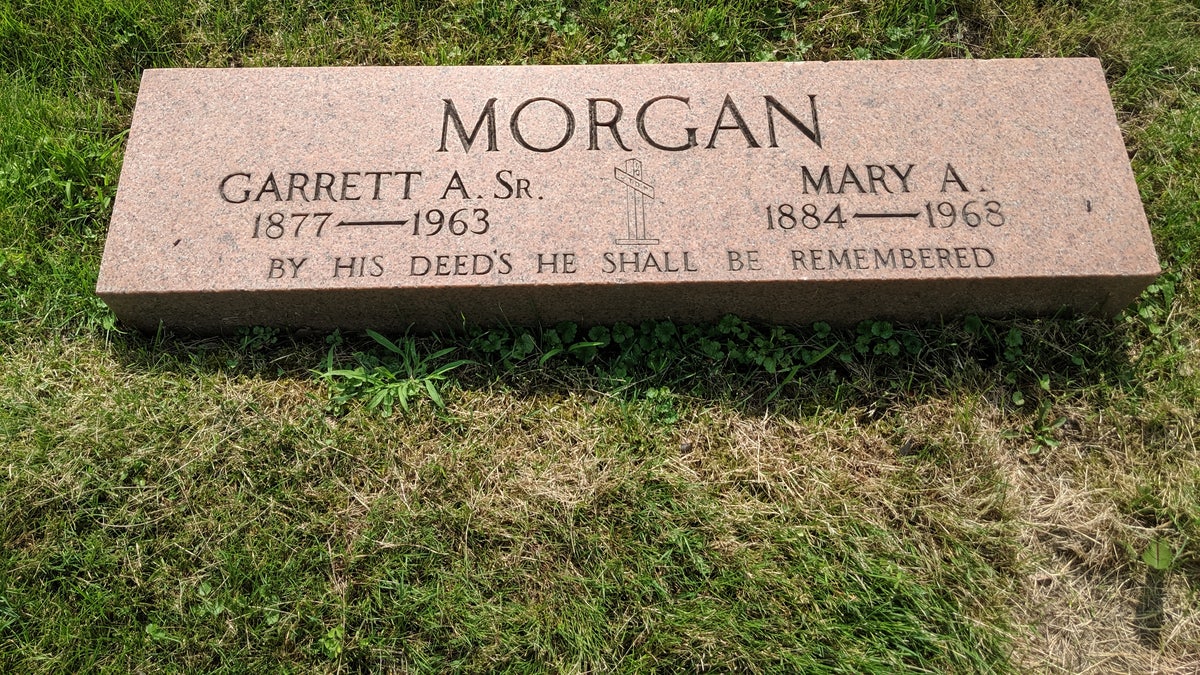
Garrett Morgan died on July 27, 1963, at 86 years old. He’s buried alongside his wife beneath a humble gravestone at Lake View Cemetery in Cleveland. (Tours of Cleveland LLC)
“It’s the greatest invention that a firefighter could ever have.”
Morgan was inducted into the National Inventors Hall of Fame in 2005. He is the namesake of the Garrett Morgan School of Leadership & Innovation, a sparkling new public high school in Cleveland; Garrett Morgan Academy, a public high school in Paterson, N.J., and P.S. 132 Garrett A. Morgan Elementary School in Bronx, N.Y.
CLICK HERE TO SIGN UP FOR OUR LIFESTYLE NEWSLETTER
The Cleveland Call, a newspaper he founded to serve the Black community in 1916, continues to dish out news today to readers in Cleveland, Columbus and Cincinnati as the Cleveland Call & Post.
His achievements are taught in public school social studies courses in Ohio, even if they’re largely unknown around the rest of the country.

Garrett A. Morgan was of White, Black and Native American descent. His grandfather was Civil War Confederate Gen. John Hunt Morgan, while his parents were both former slaves. The medal on his lapel is unidentified, but he was active and/or founded many civic organizations during his life. (Elroy Sanford photographer/Western Reserve Historical Society)
Perhaps most notably, the Morgan family continues to thrive in the Cleveland area. Great-grandson Garrett A. Morgan IV, an Ohio artist, turns 47 this week.
CLICK HERE TO GET THE FOX NEWS APP
Garrett A. Morgan “was a complex man, a very creative, very curious man who had a strong sense of the public good,” granddaughter Sandra Morgan said.
“Family was important to him. Community was important to him. He’d be thrilled and very excited to know that he was now being recognized this way.”
To read more stories in this unique “Meet the American Who…” series from Fox News Digital, click here.
